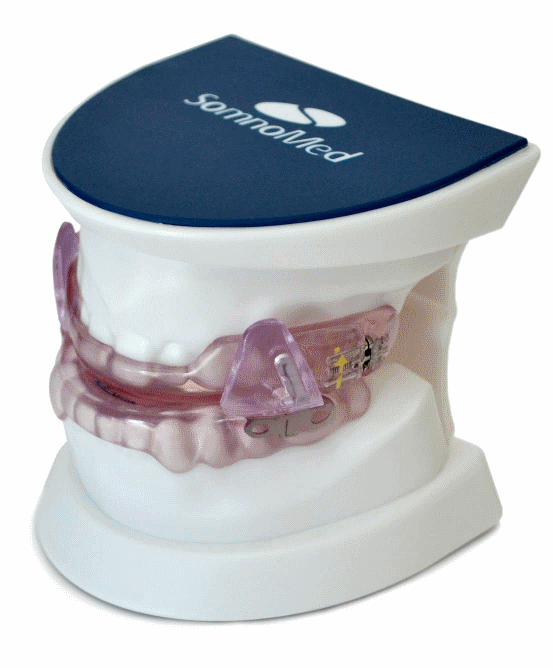
01 May Retrognathia and the use of a Mandibular Advancement Splint (MAS) to treat OSA.
There are certain facial features and measurements that are associated with reduced upper airway volume and increased risk of OSA. The dimensions of the upper airway are primarily determined by the mandible and the hyoid bone. The more frequently identified features include mandibular deficiency, a hyoid bone located lower down the neck, a narrowed internal air space, elongation of the soft palate, reduced maxillary (upper jaw) and mandibular length, as well as larger tongues relative to the oral cavity and narrower nasopharyngeal airways[1,2].
Whilst there are other maxillofacial abnormalities that can cause difficult airway management, many of the anatomical features frequently associated with OSA are seen in retrognathia – which is when the mandible sits abnormally further back relative to the maxilla due to mandibular deficiency. Patients with retrognathia therefore may be more prone to airway collapse during sleep considering there is little muscle involvement in keeping the airway open[4]. Specifically, retrognathia has been found to be associated with excessive backwards positioning of the tongue and mouth soft tissues whilst lying in supine position, which increases the likelihood of upper airway obstruction[2].
As well as the link to OSA, retrognathia can have other negative impacts on the quality of life of patients. The abnormal growth of the jaw can produce teeth misalignment that prevents patients from chewing properly, and there can be a psychological aspect due to the appearance of the jaw. A patient can be born with retrognathia or develop it after birth, and the most common causes include Pierre-Robin Syndrome, hemifacial microsomia, Nager Syndrome, Treacher Collins Syndrome, tumor removal surgery, and facial trauma [3]. Retrognathia can be diagnosed both as an adult using physical examination and CT scans, and as a fetus via ultrasound by taking various measurements of the facial bones, including the inferior facial angle, the jaw index, the mandibular width/maxillary width ratio, and the mandibular ratio[4].
Treatment
The preferred treatment for OSA is CPAP. For some patients, an alternative to CPAP is the use of a mandibular advancement splint (MAS), which has been shown to reduce the frequency of obstructive breathing events during in lab sleep analysis[5,6]. A MAS is an oral device that is designed to increase the airway space by bringing forward the lower jaw. It can be titrated to a particular level of jaw movement according to the needs of the patient[7].
The RACGP claims that use of a MAS for patients with mild to moderate OSA is comparable to CPAP[8]. However, the MAS isn’t necessarily effective for all patients. A positive response to MAS treatment has been linked to various attributes including retrognathia, lower BMI, smaller neck circumference, female gender, more backwards positioned tongue, and shorter airway length[2]. It is also better suited to patients with lower severity of OSA and supine-dependent OSA[9]. Patients who are more unlikely to respond to a MAS include those older in age with obesity and high neck circumference, increased nasal resistance, collapse of the airways occurring at the palate or epiglottis, a very stiff jaw, and dental conditions[10].
Comparison of the efficacy of CPAP vs a MAS short term shows similar results, however over the long term it appears that CPAP provides superior treatment for OSA, including those with jaw displacement such as in retrognathia[5]. MAS therefore can be a great adjunct treatment, particularly for those with access limitations or dislike for CPAP, as it is also less expensive, more convenient, and more easily accessed. A MAS can also be used in conjunction with CPAP, particularly for patients with retrognathia, as it can increase the oropharyngeal airway dimension and potentially reduce the amount of pressure required from CPAP.
Alternatively, surgical mandibular advancement (MMA) is another effective option to increase airway volume in patients displaying retrognathia associated with OSA, and in some patients it has shown to provide complete reversal of OSA symptoms[10].
References
- Cistulli PA. Craniofacial abnormalities in obstructive sleep apnoea: implications for treatment. Respirology. 1996;1(3):167-174. doi:10.1111/j.1440-1843.1996.tb00028.x
- Johal A, Patel SI, Battagel JM. The relationship between craniofacial anatomy and obstructive sleep apnoea: a case-controlled study. J Sleep Res. 2007;16(3):319-326. doi:10.1111/j.1365-2869.2007.00599.x
- Jenzer AC, Schlam M. Retrognathia. StatPearls Publishing; 2020.
- Sanz-Cortés, M, Gómez O, Puerto/ Micrognathia and Retrognathia, In: Copel JA, D’Alton ME, Feltovich H, Gratacós E, Krakow D, Odibo AO, Platt LD, Tutschek B, eds. Obstetric Imaging: Fetal Diagnosis and Care. 2nd ed. Elsevier, 2018:321-327 Accesses February 2024 https://doi.org/10.1016/B978-0-323-44548-1.00068-1.
- White DP, Shafazand S. Mandibular advancement device vs. CPAP in the treatment of obstructive sleep apnea: are they equally effective in Short term health outcomes?. J Clin Sleep Med. 2013;9(9):971-972. doi:10.5664/jcsm.3008
- François C, Bonafé A, Roubille C, Roubille F, Dupuy-Bonafé I, Millot S. Patients with Obstructive Sleep Apnea and Cardiovascular Diseases: What, When, and Why Is Mandibular Advancement Device Treatment Required? A Short Review. J Clin Med. 2022;11(22):6845. doi:10.3390/jcm11226845
- Pattipati M, Gudavalli G, Zin M, et al. Continuous Positive Airway Pressure vs Mandibular Advancement Devices in the Treatment of Obstructive Sleep Apnea: An Updated Systematic Review and Meta-Analysis. Cureus. 2022;14(1):e21759. doi:10.7759/cureus.21759
- “Mandibular Advancement Devices: Obstructive Sleep Apnoea.” Mandibular Advancement Devices: Obstructive Sleep Apnoea, Royal Australasian College of General Practitioners, Jan. 2016, www.racgp.org.au/getattachment/d5d13af4-d28e-445c-b388-e5cba6cb442a/Mandibular-devices-for-obstructive-sleep-apnoea.aspx.
- Hui Chen, Danny J. Eckert, Paul F. van der Stelt, Jing Guo, Shaohua Ge, Elham Emami, Fernanda R. Almeida, Nelly T. Huynh. Phenotypes of responders to mandibular advancement device therapy in obstructive sleep apnea patients: A systematic review and meta-analysis. Sleep Medicine Reviews. 2020:49(101229) 1087-0792. https://doi.org/10.1016/j.smrv.2019.101229.
- Waghchaure SS, Bhad WA, Chavan SJ, Mehta N, Baheti N. Effectiveness of Surgical Mandibular Advancement in Improving Airway Dimensions in Nongrowing Skeletal Class II Patients With Obstructive Sleep Apnea—A CBCT Study. Journal of Indian Orthodontic Society. 2023;57(2):106-115. doi:10.1177/03015742221076914

